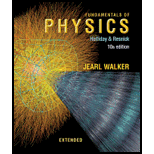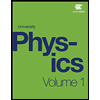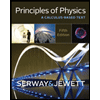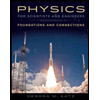
Concept explainers
In a first experiment, a sinusoidal sound wave is sent through a long tube of air. transporting energy at the average rate of Pavg, 1· In a second experiment, two other sound waves, identical to the first one, are to be sent simultaneously through the tube with a phase difference ϕ of either 0, 0.2 wavelength, or 0.5 wavelength between the waves, (a) With only mental calculation, rank those choices of ϕ according to the average rate at which the waves will transport energy, greatest first, (b) For the first choice of ϕ, what is the average rate in terms of Pavg, 1?
To find:
a) The rank of phase difference according to the average rate of transport of energy by the waves, greatest first.
b) The average rate of energy transport for the first choice in (a).
Answer to Problem 1Q
Solution:
a) The rank of phase difference according to the average rate of transport of energy by the waves, greatest first, is
b) The average rate of energy transport for (a)
Explanation of Solution
1) Concept:
The rate of energy transported by a travelling wave depends on the intensity of the wave as well as the area to which the energy is transported. The intensity of a resultant wave depends on the phase difference between the two superposing waves.
2) Formula:
3) Given:
i) The average rate of energy transported by a single wave =
ii) The phase difference between the two waves sent through the pipe are
4) Calculations:
a) The rate of energy transported is given by
When two waves are sent with phase difference
Thus, the rate of energy transport for
When two waves are sent with phase difference
Hence, the resultant intensity will be more than the single wave but less than that for
When two waves are sent with phase difference
Hence, the ranking of the situations will be
b) Since the amplitude of the resultant wave is twice the single wave, intensity is four fold. Hence, the rate of energy transported will be
Conclusion:
The energy transported by a wave can be calculated by using the intensity of the wave. Here, the intensity changes according to the phase difference between the two superposing waves. Hence the rate of energy transported changes as the phase difference changes.
Want to see more full solutions like this?
Chapter 17 Solutions
Fundamentals of Physics Extended
Additional Science Textbook Solutions
Cosmic Perspective Fundamentals
Essential University Physics: Volume 2 (3rd Edition)
Conceptual Physical Science (6th Edition)
Conceptual Integrated Science
The Cosmic Perspective Fundamentals (2nd Edition)
Physics for Scientists and Engineers with Modern Physics
- Two sinusoidal waves are moving through a medium in the same direction, both having amplitudes of 3.00 cm, a wavelength of 5.20 m, and a period of 6.52 s, but one has a phase shift of an angle . What is the phase shift if the resultant wave has an amplitude of 5.00 cm? [Hint: Use the trig identity sinu+sinv=2sin(u+v2)cos(uv2)arrow_forwardTwo sinusoidal waves are moving through a medium in the positive x-direction, both having amplitudes of 7.00 cm, a wave number of k=3.00 m-1, an angular frequency of =2.50 s-1, and a period of 6.00 s, but one has a phase shift of an angle =12 rad. What is the height of the resultant wave at a time t=2.00 s and a position x=0.53 m?arrow_forwardA cable with a linear density of =0.2 kg/m is hung from telephone poles. The tension in the cable is 500.00 N. The distance between poles is 20 meters. The wind blows across the line, causing the cable resonate. A standing waves pattern is produced that has 4.5 wavelengths between the two poles. The air temperature is T=20C . What are the frequency and wavelength of the hum?arrow_forward
- A string is fixed at both end. The mass of the string is 0.0090 kg and the length is 3.00 m. The string is under a tension of 200.00 N. The string is driven by a variable frequency source to produce standing waves on the string. Find the wavelengths and frequency of the first four modes of standing waves.arrow_forwardIn Figure OQ14.3, a sound wave of wavelength 0.8 m divides into two equal parts that recombine to interfere constructively, with the original difference between their path lengths being |r2 − r1| = 0.8 m. Rank the following situations according to the intensity of sound at the receiver from the highest to the lowest. Assume the tube walls absorb no sound energy. Give equal ranks to situations in which the intensity is equal. (a) From its original position, the sliding section is moved out by 0.1 m. (b) Next it slides out an additional 0.1 m. (c) It slides out still another 0.1 m. (d) It slides out 0.1 m more. Figure OQ14.3arrow_forwardA sound wave can be characterized as (a) a transverse wave, (b) a longitudinal wave, (c) a transverse wave or a longitudinal wave, depending on the nature of its source, (d) one that carries no energy, or (e) a wave that does not require a medium to be transmitted from one place to the other.arrow_forward
- A steel wire of length 30.0 m and a copper wire of length 20.0 m, both with 1.00-mm diameters, are connected end to end and stretched to a tension of 150 N. During what time interval will a transverse wave travel the entire length of the two wires?arrow_forwardA string of a length of 2.00 m with a linear mass density of =0.006 kg/m is attached to the end of a 2.00-m-long string with a linear mass density of =0.012 kg/m. The free end of the higher-density string is fixed to the wall, and a student holds the free end of the low-density string, keeping the tension constant in both strings. The student sends a pulse down the string. Describe what happens at the interface between the two strings.arrow_forwardAt t = 0, a transverse pulse in a wire is described by the function y=6.00x2+3.00 where xand y are in meters. If the pulse is traveling in the positive x direction with a speed of 4.50 m/s, write the function y(x, t) that describes this pulse.arrow_forward
- A taut rope has a mass of 0.180 kg and a length of 3.60 m. What power must be supplied to the rope so as to generate sinusoidal waves having an amplitude of 0.100 m and a wavelength of 0.500 m and traveling with a speed of 30.0 m/s?arrow_forwardConsider what is shown below. A 20.00-kg mass rests on a frictionless ramp inclined at 45° . A string with a linear mass density of =0.025 kg/m is attached to the 20.00-kg mass. The string passes over a frictionless pulley of negligible mass and is attached to a hanging mass (m). The system is in static equilibrium. A wave is induced on the string and travels up the ramp. (a) What is the mass of the hanging mass (m)? (b) At what wave speed does the wave travel up the string?arrow_forwardThe area of a typical eardrum is about 5.00 X 10-5 m2. (a) (Calculate the average sound power incident on an eardrum at the threshold of pain, which corresponds to an intensity of 1.00 W/m2. (b) How much energy is transferred to the eardrum exposed to this sound lor 1.00 mill?arrow_forward
 University Physics Volume 1PhysicsISBN:9781938168277Author:William Moebs, Samuel J. Ling, Jeff SannyPublisher:OpenStax - Rice University
University Physics Volume 1PhysicsISBN:9781938168277Author:William Moebs, Samuel J. Ling, Jeff SannyPublisher:OpenStax - Rice University Principles of Physics: A Calculus-Based TextPhysicsISBN:9781133104261Author:Raymond A. Serway, John W. JewettPublisher:Cengage Learning
Principles of Physics: A Calculus-Based TextPhysicsISBN:9781133104261Author:Raymond A. Serway, John W. JewettPublisher:Cengage Learning Physics for Scientists and Engineers: Foundations...PhysicsISBN:9781133939146Author:Katz, Debora M.Publisher:Cengage Learning
Physics for Scientists and Engineers: Foundations...PhysicsISBN:9781133939146Author:Katz, Debora M.Publisher:Cengage Learning Physics for Scientists and Engineers, Technology ...PhysicsISBN:9781305116399Author:Raymond A. Serway, John W. JewettPublisher:Cengage Learning
Physics for Scientists and Engineers, Technology ...PhysicsISBN:9781305116399Author:Raymond A. Serway, John W. JewettPublisher:Cengage Learning



